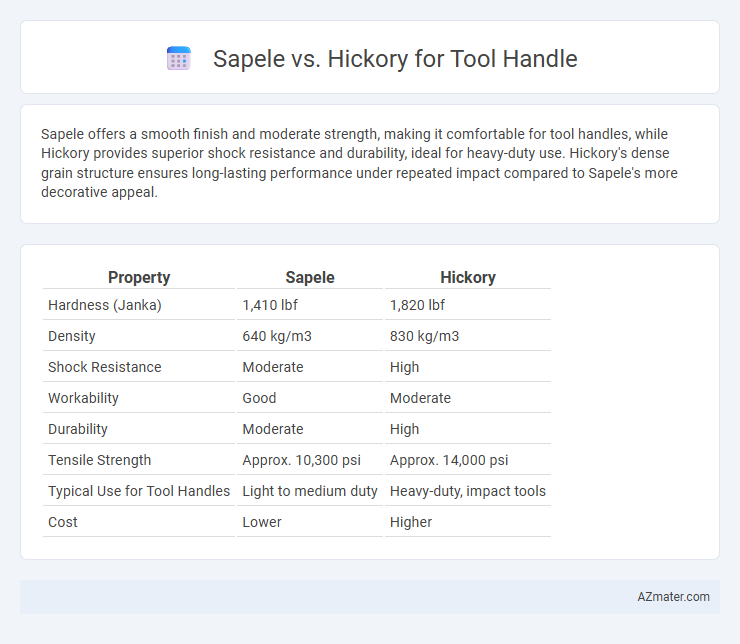Sapele offers a smooth finish and moderate strength, making it comfortable for tool handles, while Hickory provides superior shock resistance and durability, ideal for heavy-duty use. Hickory's dense grain structure ensures long-lasting performance under repeated impact compared to Sapele's more decorative appeal.
Table of Comparison
| Property | Sapele | Hickory |
|---|---|---|
| Hardness (Janka) | 1,410 lbf | 1,820 lbf |
| Density | 640 kg/m3 | 830 kg/m3 |
| Shock Resistance | Moderate | High |
| Workability | Good | Moderate |
| Durability | Moderate | High |
| Tensile Strength | Approx. 10,300 psi | Approx. 14,000 psi |
| Typical Use for Tool Handles | Light to medium duty | Heavy-duty, impact tools |
| Cost | Lower | Higher |
Introduction to Sapele and Hickory as Tool Handle Materials
Sapele and Hickory are both hardwoods commonly used for tool handles, valued for their durability and strength. Sapele, an African hardwood, offers a dense, fine grain with excellent shock resistance and a smooth finish ideal for precision tools. Hickory, native to North America, is renowned for its exceptional toughness and flexibility, making it a preferred choice for heavy-duty tool handles that require impact absorption.
Physical Properties: Sapele vs Hickory
Sapele offers moderate hardness at around 1,450 lbf on the Janka scale, making it durable but slightly less impact-resistant than Hickory, which measures approximately 1,820 lbf and is renowned for exceptional shock absorption and toughness. Sapele's density ranges between 640 to 700 kg/m3, providing a balanced weight ideal for tool handles, whereas Hickory is denser, averaging about 830 to 960 kg/m3, contributing to its superior strength and wear resistance. The interlocked grain of Sapele offers good stability with moderate flexibility, while Hickory's straight, coarse grain enhances resilience, reducing the likelihood of splintering or breaking under heavy use.
Strength and Durability Comparison
Sapele wood offers moderate strength and durability, making it suitable for tool handles that require a balance of resilience and workability. Hickory is renowned for its exceptional strength, shock resistance, and durability, making it the preferred choice for heavy-duty tool handles subjected to frequent impact. The density and hardness of hickory provide superior longevity compared to sapele, especially in demanding applications.
Weight and Balance Considerations
Sapele wood offers a moderate weight and fine grain, providing a well-balanced tool handle that enhances control and reduces fatigue during prolonged use. Hickory is denser and heavier, delivering superior shock resistance and durability, which shifts the balance towards strength but may increase user fatigue in extended tasks. Choosing between Sapele and Hickory depends on prioritizing lightweight maneuverability or robust impact absorption for tool handles.
Shock Absorption and Comfort in Use
Sapele wood offers moderate shock absorption with a smooth grain that enhances comfort, making it a reliable choice for tool handles requiring durability and aesthetic appeal. Hickory stands out for exceptional shock absorption and resilience, reducing user fatigue during prolonged use due to its dense, fibrous structure. For maximum comfort and impact resistance in tool handles, hickory is often preferred over sapele because of its superior ability to absorb vibrations.
Resistance to Wear, Splitting, and Impact
Sapele wood offers moderate resistance to wear and impact, making it a durable choice for tool handles, while hickory stands out with superior toughness and exceptional resistance to splitting and impact due to its dense, fibrous grain structure. Hickory's combination of hardness and shock absorption ensures longevity in high-stress applications, whereas Sapele provides decent wear resistance with a smoother finish and less weight. For tool handles requiring maximum durability and impact resistance, hickory generally outperforms Sapele in maintaining integrity under heavy use.
Workability: Shaping and Finishing
Sapele offers moderate workability with a fine, interlocking grain that requires sharp tools to avoid tear-out but finishes to a smooth, attractive surface ideal for tool handles. Hickory is highly favored for its exceptional workability, combining toughness with ease of shaping and sanding, which allows for precise contours and a reliable grip. Both woods hold finishes well, but Hickory's density provides a slightly more durable surface for heavy-duty tool handle use.
Cost and Availability of Sapele and Hickory
Sapele, a tropical hardwood native to West Africa, tends to be more expensive and less readily available than Hickory, which is abundant in North America and widely used for tool handles due to its toughness and shock resistance. The higher cost of Sapele is influenced by importation fees and limited supply chains, whereas Hickory's cost-efficiency and local abundance make it a popular choice for durable, cost-effective tool handles. Availability of Hickory in various grades ensures consistent pricing, while Sapele's exotic status can lead to fluctuating prices and sporadic availability in the tool handle market.
Environmental Impact and Sustainability
Sapele wood, sourced from West African forests, offers greater sustainability due to its faster growth rate and certification under responsible forestry programs like FSC, reducing deforestation risks compared to hickory. Hickory, native to North America, is more dense and durable but often sourced from slower-growing trees, which may impact long-term forest regeneration. Using Sapele for tool handles helps minimize environmental impact by promoting sustainable harvesting and reducing carbon footprint linked to extended growth cycles of hickory.
Which Wood to Choose: Sapele or Hickory for Tool Handles?
Sapele offers a smooth finish, moderate hardness, and good resistance to wear, making it suitable for tool handles that require durability and aesthetics. Hickory is renowned for its exceptional toughness, shock resistance, and flexibility, which helps absorb impact, making it the preferred choice for heavy-duty tool handles such as hammers and axes. For tools subjected to high impact and stress, hickory provides superior performance, while sapele suits lighter, precision tools needing a balance of strength and appearance.

Infographic: Sapele vs Hickory for Tool Handle
 azmater.com
azmater.com